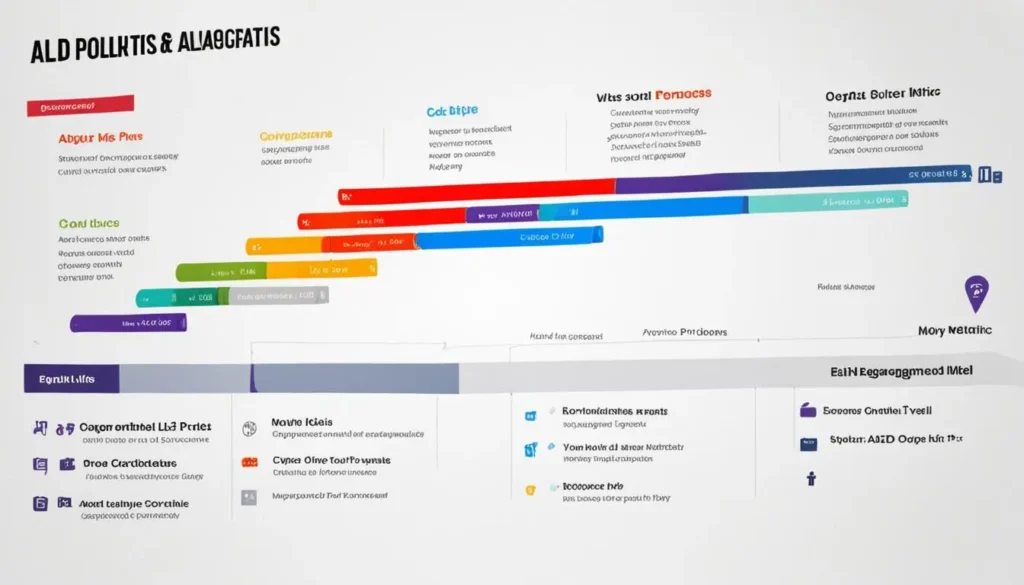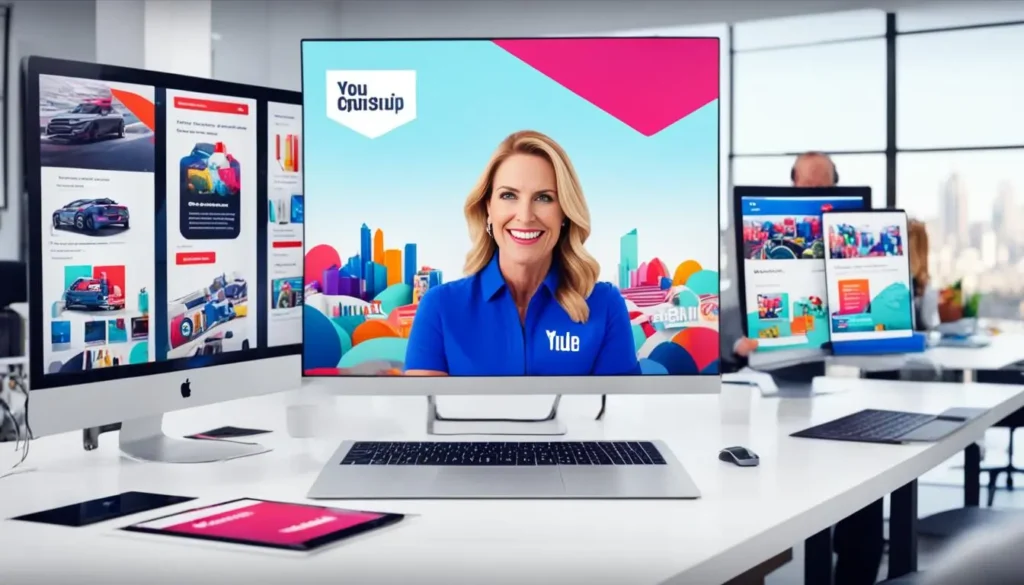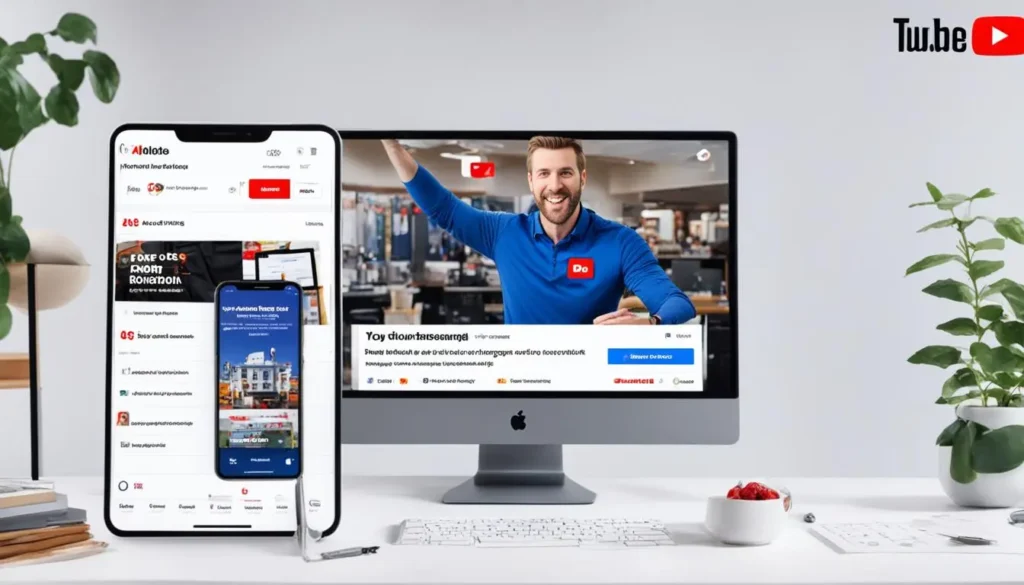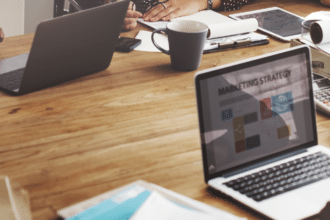Is your digital video ads strategy ready to reach over a billion users? Or are you missing chances to engage on the top video platform1
YouTube Video Reach campaigns are changing everything. They let advertisers use different ad styles to connect better with their audiences1. More than half of all YouTube views happen on mobile2. And, it’s possible to start advertising for just $0.10 per action2. This means big chances for your brand and messaging to connect with viewers everywhere2.
With Youtube’s detailed targeting, you can aim your ads directly at certain groups. This precise approach helps you get more from your budget, increasing your return on ad spend and conversions23. It’s about hitting the right audience, making every dollar you spend on ads count towards solid results.3.
Key Takeaways
- Capitalize on mobile viewership which dominates YouTube views2.
- Leverage Video Reach campaigns to optimize exposure within your budget1.
- Engage target audiences with tailored ad formats and targeting strategies23.
- Implement diverse bidding strategies for top-of-the-funnel campaigns and lead generation2.
- Understand how ad content specifications ensure maximum impact of your message1.
- Use resolution and aspect ratio guidelines to enhance video ad quality1.
Understanding the Types of YouTube Ads
YouTube is a key player in online marketing. It offers many ad formats for different campaigns. These ad types help advertisers connect well with their audiences. They do this by using unique content and models of interaction.
Skippable In-Stream Ads
Skippable in-stream ads allow viewers to skip after five seconds. Most are under 3 minutes to keep viewers interested. Advertisers only pay if the viewer watches 30 seconds or interacts with the ad4. They work well for longer stories that aim to make a deep connection with the audience.
Non-Skippable In-Stream Ads
Non-skippable in-stream ads demand full attention. They last 15 to 20 seconds and play before, during, or after videos5. Viewers can’t skip them. Advertisers pay based on impressions here. It’s great for campaigns aiming at large brand awareness.
In-Feed Video Ads
In-feed video ads pop up in search results or the homepage. They are less intrusive and ideal for new brand introductions. Advertisers pay when viewers click or watch for 10 seconds5.
This type is perfect for a first-time introduction or a gentle sales pitch.
Bumper Ads and Sponsored Cards
Bumper ads last just six seconds and can’t be skipped. They aim for quick, memorable messages and are very effective for ad recall45. Sponsored cards link to products in the video, stimulating direct engagement. They’re a great way to connect the audience with the featured products or services.
Developing a Budget for Your YouTube Marketing Campaigns

Marketers need to know YouTube ad pricing well for cost-effective ad campaigns. YouTube has over two billion monthly users. So, it’s a great place for your brand to get seen and engage6.
Being smart about your ad budget can really help your campaign succeed. And it stops you from spending too much.
YouTube offers ads like skippable and non-skippable in-stream, video discovery, and bumper ads. Each costs differently based on things like time and where they show on YouTube6.7 To budget well, learn about CPC and CPV. They help you spend smart while meeting your goals. On average, it costs about $2,000 to reach 100,000 viewers. This shows why planning your spending carefully is key6.
- Start by setting a daily budget to manage costs. For newcomers, starting at $10 to $50 is suggested. You can change this as you learn more about your campaign’s performance and needs7.
- Companies usually aim for a 4:1 ROAS (Return on Ad Spend). This means making $4 in revenue for every $1 you spend. It helps set smart budget goals6.
- How accurate your targeting, your choice of ad types, and your bidding strategy can all impact your costs6.
For big marketing campaigns on YouTube, grasping these pricing insights is crucial. Knowing YouTube ads can reach over half of all internet users is powerful. It shows your ability to connect with a large audience7.
By using these tips, all types of businesses can run smarter cost-effective ad campaigns. This way, every dollar you spend works hard to get your brand seen and keep viewers interested on this top video platform.
Targeting Strategies for Enhanced Ad Performance
YouTube ads become more effective when advertisers use different targeting strategies. These strategies focus on specific parts of the audience. This helps the ads perform better.
Demographic and Location-Based Targeting
Advertisers can pick their audience based on age, gender, and more with demographic targeting. Location-based targeting adds another layer by focusing on specific areas. This makes the ads more relevant to people in those places.
Interest and Behavior Targeting
Behavior targeting focuses on what users like or do online. It uses info about their interests and shopping habits. This makes the ads more likely to catch the right person’s eye.
Retargeting for Higher Conversions
Retargeting helps bring back people who showed interest before. It reminds them of what they liked, which can lead to more conversions. This boosts the ads’ performance and ROI.
Statistical insights show compelling results:
| Strategy | Advantage | CPA Impact8 |
|---|---|---|
| Placement Targeting | High precision, lower risk8 | May increase depending on frequency of optimization8 |
| Demographic Targeting | Broad reach but may limit audience size if overly specific8 | Moderate |
| Retargeting | High conversion rates | Lower than average |
YouTube’s platform is vast, with over 70 billion views monthly. This makes it a vital place for digital ads. Strategies like placement targeting give advertisers a big advantage. They can target very specific audiences, sometimes down to individual videos89.
YouTube ads cost up to 30% less than search ads. This makes it an affordable choice. Plus, there are incentives like Google Ads matching up to $500 for new accounts9.
In the end, using strategies like demographic, behavior, and retargeting help marketers adjust their ads. They can then watch the performance improve. This not only gets the ads to more people but also gets them to react more, making YouTube a top spot for digital ads.
Leveraging Video Reach Campaigns for Maximum Exposure
In today’s digital world, video reach campaigns are at the forefront for getting your brand known. These campaigns mix ad types well to meet different marketing needs. They do this effectively.
Video reach campaigns bring a lot to the table. They let you use various ad types to get the most exposure without overspending1. They also offer tools like ‘Efficient reach’ and ‘Target frequency’ for better connection with your audience10.
These campaigns are very flexible. They help advertisers reach many users by using specific targeting criteria1. Plus, they’re great for saving money. For example, one campaign saw a 29% reach boost and cut CPM costs by 43%10.

For the best viewer experience, video ads should meet certain resolution and size standards. Think 1080p for great HD and 16:9 for a wide view1. The ads in .MP4 or .MOV formats can be shown on many different platforms, making them more likely to reach your audience1.
These steps help brands stand out online. Google’s smart ad tools play a big role, making ads more effective with less effort10.
| Feature | Benefit |
|---|---|
| Multi-format options | Allows customisation based on campaign goals, enhancing target audience reach1 |
| Efficient reach & AI Optimization | Maximizes reach while reducing costs, utilizing AI to fine-tune ad delivery for optimal performance10 |
| Advanced targeting criteria | Enables precise audience segmentation, increasing the relevance and effectiveness of campaigns1 |
| High-quality ad formats | Supports diverse creative expressions and achieves superior viewer engagement rates1 |
Taking advantage of these modern techniques in video reach campaigns can make a big difference. It boosts brand awareness and makes sure your ad money works hard. This helps you reach more people and make a lasting digital impression.
Crafting Effective Ad Content
Being great at YouTube video ads needs tech smarts and creative thinking. The best ads grab the viewer, meet marketing goals, and look great. This way, viewers remember the message.
Ad Creative Best Practices
Make your ad matter with short, interesting headlines and descriptions. Add a clear call-to-action. It helps viewers know what to do next and makes your ad work better.
Ad Copywriting for Engagement
Good ad writing catches people’s eyes. When ads feel personal, more people pay attention. Start strong with emotion and keep them interested with well-chosen words.
Optimizing Video Quality and Resolution
Great video quality is a must. Use settings like 1920x1080px or 1280x720px for clear visuals. This improves how the ad looks and how engaged viewers are.

To succeed in video ads, know your content and what viewers like. Tailoring ads and writing them well can make an ad campaign powerful. See how ad costs and what viewers do change in the table below.
| Element | Impact on Cost2 | Viewer Behavior11 |
|---|---|---|
| Ad Copy | Cost changes with ad details and keywords used. | 84% skip rate, ads should grab attention fast. |
| Video Quality | Better quality can cost more but often pays off with higher interest. | Makes viewers more likely to keep watching without skipping. |
| Call to Action (CTA) | CTAs boost conversions and affect ad production costs. | Strong CTAs really shape what viewers do next. |
Making video ads work well takes careful planning and smart steps. Using top ad writing methods and keeping video quality high are vital. These efforts help engage your audience and make your campaign a success.
Ad Placement and Its Impact on Viewer Engagement
The way we place advertisements on YouTube really matters. It can make a big difference in how much people pay attention to the video ads they see. This knowledge is key for making YouTube ads as effective as possible. Using ads that viewers can’t skip often leads to more money and slightly less watching time. An early 2023 study found that YouTube creators saw a 5% income boost this way12.
YouTube is also changing how ads for connected TVs are shown. This move is meant to make watching ads better and encourage more people to respond. It matches ads with what people like to watch and is especially good in long viewing sessions. This approach makes people more interested in the ads without making them want to stop watching12.

The way ads are placed is crucial. But, the methods for doing this are also getting better. YouTube will have new ad settings for creators in November. This change will match ads with viewers better without being too pushy. It’s all about keeping viewers interested but not annoyed12.
| Ad Feature | Impact on Viewer Engagement | Revenue Impact |
|---|---|---|
| Non-skippable Ads | Minimal drop in watch time | +5% revenue increase12 |
| Pre-roll Ads | +15% revenue increase12 | |
| CTV Ads | Aligned with user preferences in longer sessions | Enhanced user experience and response |
This smart use of ad features shows us the power of good ad placement. It proves that placement can make ads work better on YouTube. These tips are gold for anyone wanting to make their YouTube ads do better in catching viewers’ eyes and earning money.
Analysis of Cost Per View (CPV) in YouTube Advertising
In today’s world, knowing how to control Cost per View (CPV) matters a lot. This is key for making the most out of YouTube ads. We look at CPV in detail, showing how it fits into overall ad costs and marketing aims.
Understanding CPV Bidding Strategy
CPV bidding is crucial, especially for ads aiming at brand awareness or interaction. Advertisers pay based on how viewers interact with the ad. This could be by watching most of it or by clicking on it. Typically, this cost falls between $0.10 and $0.50. This places ads where they can get a lot of views for a set cost13. However, what’s considered a good CPV changes based on the type of industry and how past ads have done13.
Factors Influencing CPV Costs
Many things can change how much a view costs. Things like lots of companies wanting the same ad space and ads being shown to very specific audiences can make CPV higher14. The kind of audience and how interesting the ad is also matter. For example, ads in Business and Finance cost less by 17% from 2021 to 2022. This shows how the market can affect ad prices14.
Aligning CPV With Marketing Goals
Making CPV fit with your marketing goals ensures each view counts towards hitting your targets. A smart CPV plan needs to match up with how often people buy after seeing your ad. This is to make sure your ad spending brings in a good return13. Agencies use old data to guess and set CPV rates that meet their client’s specific aims13.
Here’s how looking at different CPV numbers helps with ads:
| Industry | Average CPV 2021 | Average CPV 2022 | Change (%) |
|---|---|---|---|
| Business and Finance | $0.45 | $0.37 | -1714 |
| Healthcare | $0.55 | $0.70 | +2714 |
| Travel | $0.20 | $0.21 | +614 |
To sum up, getting CPV right means understanding YouTube and the ad world around it. By having a strong CPV plan and linking it to marketing goals, advertisers can manage YouTube ad costs well and get people to really engage with their ads.
Ad Formats and Their Role in Your Advertising Goals
Learning about the different ad formats on YouTube is key to making a solid YouTube marketing strategy that helps your advertising goals. Skippable in-stream ads, for instance, let you adjust the ad’s length and how much people engage with it. This is great for Video Action Campaigns (VAC) or Video View Campaigns (VVC), making your ads more flexible to what you need5.
On the flip side, non-skippable in-stream ads deliver a short, 30-second message that everyone has to watch. They make sure viewers see the whole ad and are useful for broad reach campaigns like Video Reach Campaigns (VRC). This can help spread your message more effectively5.
Bumper ads only last 6 seconds. This quick style helps viewers remember your brand better. They work well when you first want people to know about your brand or to consider it more5. In-feed ads fit in YouTube search results or with related videos to get more eyes on your content. This helps people interested in similar content find you5.
Videos made for mobile phones are key for reaching people on the move. They can really boost your sales when used in campaigns focused on YouTube Shorts. This kind of ad fits the way people are watching videos more and more, especially on phones5.
Masthead ads have a special place at the top of the YouTube homepage. You can get this prime spot by talking to Google sales reps and booking it. They’re great for big events, like when you’re launching a new product or sharing big news about your company5.
It’s important to know how much these ads cost. Outstream ads are charged on a viewable CPM basis. This means you only pay when the ad reaches a certain number of views. It’s a smart way to make your ad budget go further5. YouTube video ads can help with a lot of marketing goals, from making people more aware of your brand to selling more of your product. They’re very flexible in a digital marketing plan.
- Skippable in-stream ads: No prescribed max length
- Non-skippable in-stream ads: Up to 30 seconds
- Bumper ads: 6 seconds, ideal for quick messages
- In-feed video ads: Great for discovery and search-related visibility
- Vertical-friendly video ads: Improve conversions on mobile
- Masthead ads: Prominent visibility for major branding efforts
| Ad Format | Duration | Main Benefit |
|---|---|---|
| Skippable In-Stream | Flexible (up to 3 mins) | Viewer choice leads to better engagement |
| Non-Skippable In-Stream | 30 seconds | Guaranteed full message delivery |
| Bumper | 6 seconds | Quick, memorable brand impacts |
| In-Feed | Variable | Enhances visibility in searches |
| Vertical-Friendly | Variable | Optimized for mobile conversions |
| Masthead | Reservation based | Prime positioning for maximum exposure |
In wrapping up, picking the right YouTube video ads is vital, no matter if you want to drive leads, grow brand awareness, or push direct sales. Each ad format has its unique benefits, helping make your ads more effective when used strategically.
Tracking and Measuring YouTube Ad Performance
For digital video marketers, tracking ad performance is key. They need to use YouTube analytics to see how well their ads do. This helps them make ads more effective. They can do this by using A/B testing and focusing on key performance indicators (KPIs).
Key Performance Indicators (KPIs) for YouTube Ads
Measuring YouTube ad performance is crucial. Important indicators include view rates and click-through rates (CTR). The view-through rate (VTR) also matters. This shows how good ads are at keeping viewers interested. ROI helps in adjusting budgets and strategies.
Utilizing Analytics for Campaign Improvement
YouTube provides tools to dive deep into analytics. These are key to making ads better and reaching the right viewers. YouTube Studio shows a lot about a video’s performance and who’s watching. This helps marketers improve their targeting and content.
A/B Testing for Optimizing Ad Elements
A/B testing lets marketers try different ad elements. This includes things like thumbnails and messages. It helps them figure out what works best to engage viewers. YouTube analytics’ “Ads data” and “Organic data” views give insights on user interactions. These insights help improve campaign performance.
| Element | Modification | View Rate Impact | CTR Improvement |
|---|---|---|---|
| Thumbnail | High-contrast colors | +5% | +3% |
| Call-to-Action | More direct phrasing | +7% | +7% |
| Video Length | Reduction to 30 secs | +10% | +2% |
Using these methods, marketers can greatly improve their YouTube campaigns. They can boost engagement and get more from their investments.
Conclusion
The world of video advertising on YouTube calls for a smart approach. Campaign success means having a thought-out strategy. YouTube is huge, being the second biggest search engine globally. This means it’s a great place to reach a massive audience. There are billions of users watching all kinds of content, from how-tos to fun stuff17.
The ads that work best, according to Google, are between 20 seconds and 3 minutes long. They pull viewers in with stories that they find interesting. When making these ads, it’s important to focus on quality, tell a good story, and maybe add some jokes. Good ads don’t just stick in people’s minds. They can also help build a loyal following1817.
It’s key to choose the right type of ad, whether it’s Skippable, Non-skippable, or maybe a short Bumper ad. This choice is all about matching your content with what your viewers like. You also need to think about how often your ad shows up, so people don’t get tired of it. And it’s smart to place your ads where they’ll get the most attention18.
Using data to understand how your videos are doing is also important. This helps keep your videos fresh and on point. It’s crucial to know how YouTube’s financial side works, too. Making the most of the 55% of ad money that goes to creators is a big part of doing well financially19.
Looking forward, successful advertising on YouTube is all about knowing your viewers, telling great stories, and using the right data. Mixing these things wisely is how you make ads that not only get noticed but also connect deeply with people. This approach can help your ads reach more and really make a difference. In the end, creativity and smart data use make the winning formula in the digital ad world. And that’s where the real magic happens.
FAQ
How does an effective YouTube ads strategy boost my reach and engagement?
A great YouTube ads plan can help you connect with your audience better. It does this through personalized video ads. By using different ad types and targets, you can catch viewers’ attention with content they love. This ensures your message is heard loud and clear, boosting both your reach and engagement.
What are the different types of YouTube ad formats available?
There are many ad formats on YouTube, such as skippable in-stream ads and bumper ads. These ads can help with various goals, from spreading brand awareness to driving traffic to your website.
How can I develop a budget for my YouTube marketing campaigns?
When planning your YouTube ad budget, think about your audience, objectives, and how many people you want to reach. It’s good to set a daily budget and pick a cost model that fits your goals. This way, you can run your campaigns in a smart and budget-friendly way.
What targeting strategies can enhance my YouTube ad performance?
You can make your ads stand out more by using smart targeting. This means aiming your ads at specific groups based on things like location or interests. You can also try retargeting to remind people who have shown interest in your brand to check you out again.
How can video reach campaigns maximize my brand exposure on YouTube?
Video reach campaigns offer a budget-friendly way to reach a larger audience on YouTube. They combine different ad types to make the most of your budget. You can choose options like efficient reach or non-skippable in-stream ads to make sure your message is seen and heard.
What are some best practices for crafting effective ad content on YouTube?
Good YouTube ad content is short, to the point, and calls people to act. Make sure your video looks great and runs smoothly. This way, viewers will enjoy watching it and might even share it with others.
How does ad placement impact viewer engagement on YouTube?
Where you place your ad on YouTube makes a big difference in how viewers respond. Putting your ad where it’s sure to be seen can lead to more clicks and interactions. This can really boost how people engage with your ad.
What is CPV and how does it factor into YouTube advertising?
CPV is a key part of YouTube advertising. It’s a cost model where you pay each time someone watches your ad for at least 30 seconds or interacts with it. This is great for ads focused on spreading awareness, as it means you’re reaching people who are more likely interested.
How should I choose ad formats to meet my advertising goals on YouTube?
Pick ad formats on YouTube based on what part of the marketing funnel you’re working on. Use in-feed ads to get more visibility or bumper ads for quick, memorable messages. Choosing the right format for your goals is crucial for your YouTube ads to succeed.
Why is tracking and measuring ad performance important in YouTube campaigns?
Keeping track of how your ads are doing on YouTube is crucial for knowing what works. By looking at data and testing different approaches, you can make your ads better. This leads to more engagement and better results from your ads.
Source Links
- https://support.google.com/google-ads/answer/10581234?hl=en
- https://blog.hubspot.com/marketing/youtube-video-advertising-guide
- https://www.wordstream.com/blog/ws/2017/02/23/youtube-advertising-tips
- https://snapshotinteractive.com/explaining-the-5-different-types-of-youtube-ads/
- https://support.google.com/youtube/answer/2375464?hl=en
















